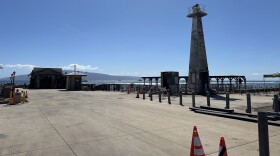The community has been waiting for over a year for answers from the U.S. Bureau of Alcohol, Tobacco, Firearms and Explosives and Maui County about the cause and origin of the Lahaina fire that killed 102 people last year.
Now that the report has been released, lawmakers want to see policies put in place and enforced to prevent future disasters.
According to the report, the Aug. 8 fire was caused by the re-energization of broken utility lines owned by Hawaiian Electric Company. The sparks from the re-energization of the poles ignited unmaintained vegetation.
Firefighters responded to the morning fire and left the scene believing that it was extinguished.
However, that afternoon the fire rekindled in a gully on Kamehameha Schools property and ignited unmanaged vegetation.
“We deeply regret that our operations contributed to the fire that ignited in the morning,” HECO wrote in a statement.
“We have looked closely at our protocols and actions that day and have made many changes in our operations and resilience strategies to ensure we fulfill our commitment to keep the public safe, especially in extreme weather events, which are becoming more frequent and severe.”
While the investigation has gone on for over a year, the results aren’t surprising.
Litigation teams working on lawsuits against HECO, the state and large landowners, like Kamehameha Schools, have presented similar findings.

Mikal Watts, an attorney representing Maui survivors involved in the $4.2 billion settlement, explained that the ATF report just makes those findings public.
“I knew exactly what happened, but I couldn't talk about it outside of litigation,” he said.
“Now it's a public document for everyone to see and that is healing. It's cathartic and it's also important in terms of preventing another wildfire in the future.”
Watts explained that the findings have no impact on the settlement, which is awaiting a decision by the Hawaiʻi Supreme Court due to a disagreement between plaintiffs and insurance companies on further litigation. A decision by the court is expected by early next year.
State Rep. Elle Cochran, who represents Lahaina, wanted to see more action from the county going into preparation for future wildfires.
“The report is the report, which I'm not totally surprised about. The outcome is what's been talked about,” Cochran said.
“But what I am surprised about is that it’s how many months later — and I still don't really feel there's a solid answer or solutions or a mitigation plan to address what we already know has happened and to be preventative on a bigger level, not just, 'Everybody take care of your own household things.'”
During Maui County’s presentation on Wednesday, officials were asked about lessons learned. They emphasized the public’s responsibility to protect themselves, such as hardening their homes and personal fire safety.

However, Cochran said there needs to be more precautions in place to ensure there’s enough water supply in Lahaina — especially with temporary housing being built in the area — and backup communication networks, which failed during the August fire.
“ I want to hear more about next steps in mitigation. So we do not suffer such a catastrophe again, or anywhere in our islands,” she said.
Maui County plans to send inspectors, before fire season, to notify landowners about what vegetation needs to be managed and to give a notification of warning to those that aren’t in compliance. If the landowners still do not comply within 30 days, the county will be issuing notices of violations.
“We give direct orders on what to do to the land and to maintain it. Therefore, we shouldn't have to go back to babysit lots over and over again,” said Maui Fire Chief Brad Ventura.
“But when we look across the landscape at what ... we should be cutting, we really have to make sure our fire code is manageable. We have to make sure we don't put unrealistic expectations on people," he said.
Gov. Josh Green has asked the attorney general’s office to compile a list of the top 10 recommendations from a different report on the Maui fire, which was issued last month, to be introduced as bills next legislative session.






